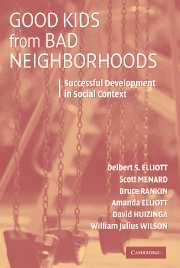Book contents
- Frontmatter
- Contents
- List of Tables and Figures
- Foreword by Richard Jessor
- Acknowledgments
- 1 Growing Up in Disadvantaged Neighborhoods
- 2 Growing Up in Denver and Chicago: The MacArthur Neighborhood Study
- 3 Good and Bad Neighborhoods for Raising Children
- 4 The Effects of Growing Up in a Bad Neighborhood: Initial Findings
- 5 Critical Dimensions of Neighborhood Organization and Culture
- 6 The Effects of Neighborhood Organization and Culture
- 7 Family Influences: Managing Disadvantage and Promoting Success
- 8 School Climate and Types of Peer Groups
- 9 What Matters Most for Successful Youth Development?
- 10 Successful Development in Disadvantaged Neighborhoods
- Appendix A
- Appendix B
- References
- Author Index
- Subject Index
1 - Growing Up in Disadvantaged Neighborhoods
Published online by Cambridge University Press: 06 August 2009
- Frontmatter
- Contents
- List of Tables and Figures
- Foreword by Richard Jessor
- Acknowledgments
- 1 Growing Up in Disadvantaged Neighborhoods
- 2 Growing Up in Denver and Chicago: The MacArthur Neighborhood Study
- 3 Good and Bad Neighborhoods for Raising Children
- 4 The Effects of Growing Up in a Bad Neighborhood: Initial Findings
- 5 Critical Dimensions of Neighborhood Organization and Culture
- 6 The Effects of Neighborhood Organization and Culture
- 7 Family Influences: Managing Disadvantage and Promoting Success
- 8 School Climate and Types of Peer Groups
- 9 What Matters Most for Successful Youth Development?
- 10 Successful Development in Disadvantaged Neighborhoods
- Appendix A
- Appendix B
- References
- Author Index
- Subject Index
Summary
We have this one little guy, 13 years old … You can just see him, every day, trying to decide which is more glamorous, the Youth Council or the Foote Street Posse. The Foote Street Posse boys offer him five hundred dollars a week to be a lookout. All we offer is knowledge. They win, hands down, most every time.
Finnegan, Cold New World, 1998:26INTRODUCTION
There is widespread concern that the social fabric of American community life has deteriorated, and this breakdown in neighborhood quality is directly responsible for the high rates of youth crime, substance abuse, unemployment, teenage pregnancy, welfare dependence, and mental health problems that characterize many of our inner-city neighborhoods. The neighborhood is generally assumed to play an essential role in raising children, and when the strong interpersonal ties, shared socialization values and processes, and effective appropriation and utilization of community resources fail to materialize or develop in the neighborhood, children are put at risk for poor developmental outcomes and dysfunctional lifestyles. The saying, “It takes a village to raise a child,” captures this perspective on the importance of neighborhoods for a successful course of child and youth development.
This is the perspective typically taken by youth and parents in the study reported in this book. For both, the neighborhood is seen as an important context that shapes family and peer activities and individual developmental outcomes. The following exchange took place in a focus group meeting in one of our Chicago study neighborhoods.
- Type
- Chapter
- Information
- Good Kids from Bad NeighborhoodsSuccessful Development in Social Context, pp. 1 - 10Publisher: Cambridge University PressPrint publication year: 2006



